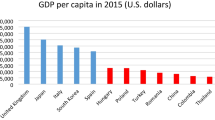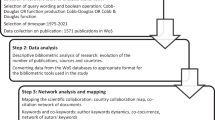Abstract
This articlefocuses on the relative levels of farm sector productivity forthe United States and nine European countries for the period1973 to 1993. At the beginning of the period, Belgium had thehighest level of productivity relative to the United States at1.689. Ireland had the lowest relative productivity at 0.759.By 1993, the range of levels of productivity had narrowed significantly,from 0.709 for Ireland to 1.392 forthe Netherlands. Further evidence of convergence can be seenin the coefficient of variation, which fell steadily from 0.261in 1973 to 0.227 in 1993. Results based on regressionanalysis show a highly significant inverse relation between therate of productivity convergence and the initial level of productivity,consistent with the ``catch-up'' hypothesis. The results generallysupport the existence of a positive interaction between capitalaccumulation and productivity growth, suggesting embodiment.
Similar content being viewed by others
References
Ball, V. E. (1985). “Output, Input, and Productivity Measurement in U.S. Agriculture, 1948–79.” American Journal of Agricultural Economics 67, 475–86.
Ball, V. E., J-C Bureau, K. Eakin, and A. Somwaru. (1997). “CAP Reform: Modelling Supply Response Subject to the Land Set-Aside.” Agriculture Economics 17, 277–288.
Ball, V. E., J-C Bureau, R. Nehring, and A. Somwaru. (1997). “Agricultural Productivity Revisited.” American Journal of Agricultural Economics, 1045–1063.
Caves, D., L. Christensen, and W. E. Diewert. (1982). “Multilateral Comparisons of Output, Input, and Productivity Using Superlative Index Numbers.” Economic Journal 92, 73–86.
Coen, Robert. (1975). “Investment Behavior in Measurement of Depreciation and Tax Policy.” American Economic Review 65, 59–74.
Diewert, W. E. (1986). “Microeconomic Approaches to the Theory of International Comparisons.” Technical Working Paper No. 53, National Bureau of Economic Research, Cambridge, Massachusetts.
Diewert, W. E. (1983). “The Theory of the Output Price Index and the Measurement of Real Output Change,” in W. E. Diewert and C. Montmarquette (eds.), Price Level Measurement. Ottawa: Statistics Canada.
Diewert, W. E. (1976). “Exact and Superlative Index Numbers.” Journal of Econometrics 4, 115–146.
“Economic Accounts for Agriculture and Forestry.” Annual. Eurostat.
Eichhorn, W. and J. Voeller. (1983). “Axiomatic Foundation of Price Indexes and Purchasing Power Parities,” in W. E. Diewert and C. Montmarquette (eds.), Price Level Measurement. Ottawa: Statistics Canada.
Eltetö, O and P. Köves. (1964). “On a Problem of Index Number Computation Relating to International Comparisons.” Szatistikai Szemle 42, 507–518.
Fisher, F. M. and K. Shell. (1972). The Economic Theory of Price Indexes. New York: Academic Press.
Fisher, I. (1922). The Making of Index Numbers. Boston: Houghton Mifflin.
Gerschenkron, A. (1952). “Economic Backwardness in Historical Perspective,” in B. F. Hoselitz (ed.), The Progress of Underdeveloped Areas. Chicago: University of Chicago Press.
Halvorsen, R. and R. Palmquist. (1980). “The Interpretation of Dummy Variables in Semilogarithmic Equations.” American Economic Review 70, 474–75.
Kennedy, P. E. (1981). “Estimation with Correctly Interpreted Dummy Variables in Semilogarithmic Equations.” American Economic Review 71, 801.
Penson, J. B., D. W. Hughes and G. L. Nelson. (1987). “Measurement of Capacity Depreciation Based on Engineering Data.” American Journal of Agricultural Economics 35, 321–329.
“Purchasing Power Parities and Real Expenditures.” Organization for Economic Cooperation and Development. Paris, 1992.
Romain, R., J. B. Penson, and R. Lambert. (1987). “Capacity Depreciation, Implicit Rental Prices, and Investment Demand for Farm Tractors in Canada.” Canadian Journal of Agricultural Economics 35, 373–78.
Szulc B. (1964). “Indices for Multiregional Comparisons.” Przeglad Statystyczny 3, 239–54.
“SPEL/EU Data 73–97.” (1997). Eurostat.
Voeller, J. (1981). “Purchasing Power Parities for International Comparisons.” Discussion Paper 161, Institut fur Wirtschaftstheorie und Operations Research, University of Karlsruhe, Karlsruhe, Germany,.
Author information
Authors and Affiliations
Rights and permissions
About this article
Cite this article
Ball, V.E., Bureau, JC., Butault, JP. et al. Levels of Farm Sector Productivity: An International Comparison. Journal of Productivity Analysis 15, 5–29 (2001). https://doi.org/10.1023/A:1026554306106
Issue Date:
DOI: https://doi.org/10.1023/A:1026554306106




